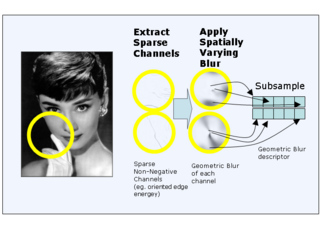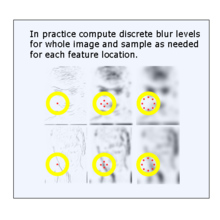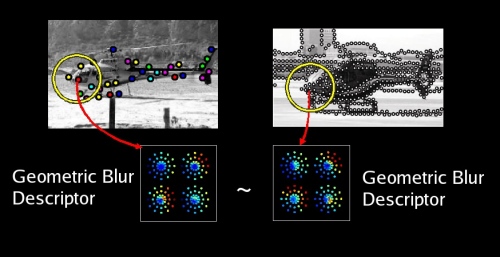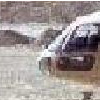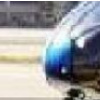Geometric Blur
Geometric blur is simply an average over geometric transformations of a signal. This turns out to be a useful operation for comparing two signals when some geometric distortion is expected. The average can be computed efficiently using a spatially varying convolution and sub-sampled to form a concise descriptor. | ||
| Original (left) Uniform Gaussian (middle) Geometric blur (right) | ||
The signal should be sparse in order for the geometric blur to produce a discriminative descriptor. An example is the output of orientation tuned edge detectors after non-max suppression. We have used descriptors based on geometric blur for matching shapes as part of object recognition, for localizing facial features, for indexing images, and more. In addition many of the same ideas show up in our work on recognizing and synthesizing actions. A study of the correlation between images of corresponding parts of objects shows a pattern close to a geometric blur over small affine transformations.
Papers
Shape Matching and Object Recognition using Low Distortion Correspondence [pdf] [ps] [ppt]Alexander C. Berg, Tamara L. Berg, Jitendra Malik
IEEE Computer Vision and Pattern Recognition (CVPR) 2005
| (Presents a descriptor based on geometric blur and applies this to object recognition.) |
Geometric Blur for Template Matching [pdf] [ps]
Alexander C. Berg, Jitendra Malik
Computer Vision and Pattern Recognition (CVPR) 2001, Hawaii, pp I.607-614
| (The original geometric blur paper concentrating on template matching and localization.) |
Shape Matching and Object Recognition [pdf] [ps]
Alexander C. Berg
Ph.D. Thesis, Computer Science Division, U.C. Berkeley, December 2005
| (Presents more detail on the motivation for geometric blur, study of corresponding image patches, etc.) |
Other work using Geometric Blur
Cue Integration in Figure/Ground Labeling.Xiaofeng Ren, Charless Fowlkes and Jitendra Malik, NIPS '05, Vancouver 2005.
Mid-level Cues Improve Boundary Detection.
Xiaofeng Ren, Charless Fowlkes and Jitendra Malik,
Berkeley Technical Report 05-1382, CSD 2005.
